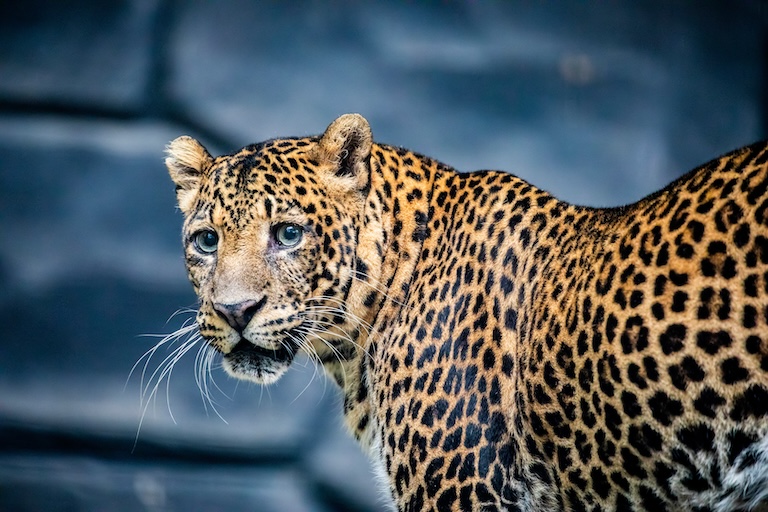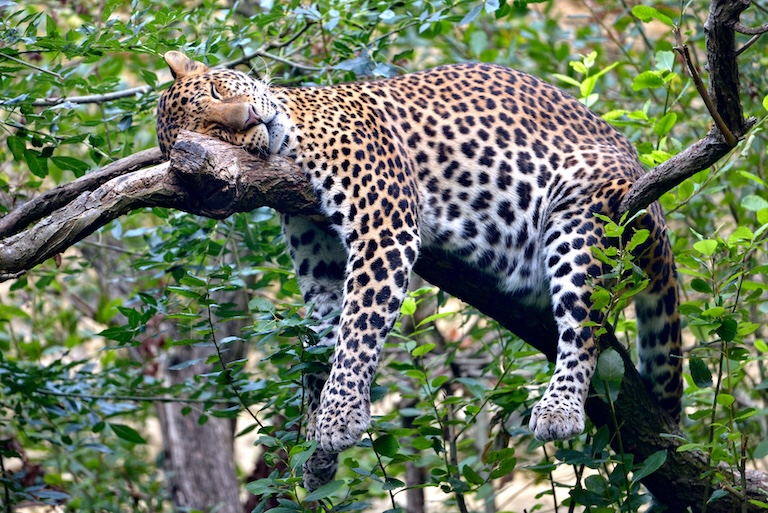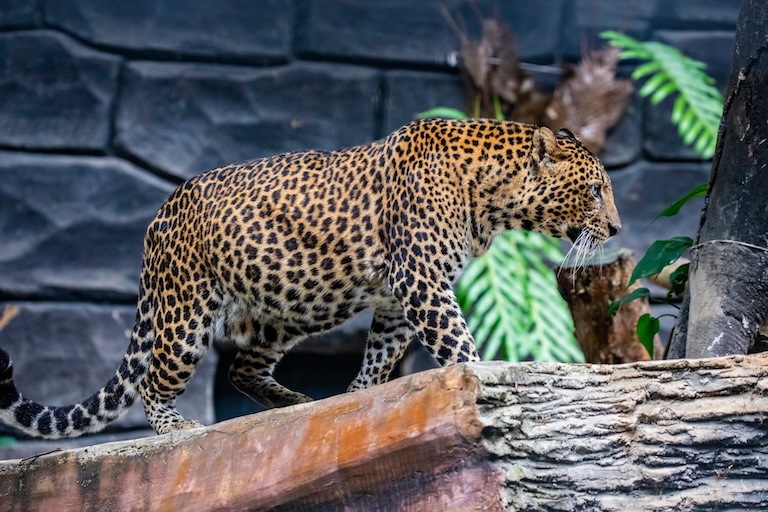Javan Leopard Profile
On the island of Java, in Indonesia, a traditional, ceremonial event called Rampokan would take place each year. The ritual battle between a lone, terrified cat and a horde of spear-wielding warriors was said to symbolise the overcoming of evil.
Wild cats were rounded up and released inside the crowd, and it was the warriors’ job to make sure they didn’t escape the circle alive.
Countless tigers met their fate this way, and even though the practice died out in the early 1900s, by the ‘80s, tigers had gone extinct on the island.
Another common victim of the ritual now risks the same outcome. The Javan leopard, once persecuted as evil, is now persecuted as a common pest, and is threatened with extinction.

Javan Leopard Facts Overview
| Habitat: | Forests, mountainous regions |
| Location: | Java, Indonesia |
| Lifespan: | Likely around 20 years |
| Size: | Around 160 cm (63 in) long |
| Weight: | Up to 90kg (200 lb) |
| Colour: | Golden brown with black spots |
| Diet: | Barking deer, wild boar, Java mouse-deer, and primates, sometimes livestock |
| Predators: | None/humans |
| Top Speed: | Likely around 58 km/h (36 mph) |
| No. of Species: | 1 subspecies |
| Conservation Status: | Endangered (IUCN) |
Javan leopards are a subspecies of African leopard, isolated on the Indonesian island of Java.
They are adaptable and powerful predators, and keystone species for their ecosystem, but their very existence is threatened by the continued encroachment of agriculture onto their habitats.
Conservation efforts are moving forward, but a lack of organisation threatens to hamper their efforts, too.
Interesting Javan Leopard Facts
1. They’re a distinct subspecies
Leopards are the most widespread big cats left on Earth. They have survived where others can’t, and now span the Earth from Africa all the way across the Middle East into Asia.
Javan leopards are the same species as the African leopard, as are mainland leopards, but they have been isolated on the Indonesian island since the Pleistocene.
Since then, they have evolved independently and are now considered a distinct subspecies from – not just a population of – the mainland leopard. 1

2. They’re adaptable
It’s hardly surprising that this animal is highly adaptable to a range of conditions on the island. In Java, leopards occupy almost every type of forest, as well as agricultural land, plantations and shrubland.
They can also be found in lowland, dry forests and savanna all the way up to 2,500m montane rainforests.
3. They’re crepuscular
These leopards are now the largest predator on the island after the tigers died out, and this lumps them with a huge responsibility to keep various animal populations down.
Their preferred method of hunting is to be active around the twilight hours of dusk and dawn, a strategy known as crepuscular.
But different populations on the island prefer different times: West Javan leopards are morning people, while the population found in Baluran National Park are night owls, spending much more time awake at night. 2
4. They’re important predators
As mentioned, the onus is now on the leopard to control wildlife populations, and it does this through a process of slaughter.
Javan leopards commonly feed on barking deer, boar, mouse deer and monkeys.
They’ll even take a gibbon or two if the opportunity presents itself, and this generalist predator approach is extremely important to reducing disease, keeping gene pools healthy, and keeping populations under control so that the ecosystem stays strong.
Unfortunately, the same opportunistic approach often brings them into contact with livestock.
5. Increases in human populations cause conflict
Increases in both human populations and the range of their agricultural practices have created points of conflict between local people and the leopards.
Even after more than a century since the grotesque Rampokan ritual, the large predators on the island are demonised as killers of livestock, and this is compounded by the fact that farmers are ever encroaching on leopard territory to rear that livestock.
At least 30% of the leopards on Java now are at high risk from human-wildlife conflict, and another 25% are at moderate risk. 46% were assessed as having a low potential for conflict, and most of these are inside protected areas. 3
6. Trafficking is also an issue
More than once a year, a Javan leopard is confiscated from traffickers. They are sold on domestic markets as stuffed animals and for traditional ritual practices.
The true rate of trafficking remains unclear, but it’s certainly a significant threat to a creature with a population size of less than 500.

7. Deforestation is a serious concern
As adaptable as this animal is, there’s no escaping habitat destruction, and the continued deforestation on Java is one of the more serious concerns for all wildlife there, especially the leopard.
Between 2000 and 2018, Java had lost approximately 2,624 km² of forest or 146 km²/year.
This rate appears to have slowed, and some reports have returned a zero net loss of forest cover during some of the subsequent years but the fragmentation and destruction may already be too much. Java now has less than 4% primary forest cover. 4
8. Java needs more protected areas
The high number of occurrences of leopards outside of protected areas suggests a simple solution: more protected areas.
Conservationists are urging that protected lands get a higher priority on the island, including wildlife corridors to connect fragmented habitats together again.
But while there’s a lot of potential space for the leopard to live in, there’s more to the conservation of animals this reduced than simply providing a home.
9. Ecology is as important as space
The ecology of a species is as important as the space that you create for them. Surveys suggested a wealth of viable land, but the population there needs to be viable for it to work.
This means that maintaining a healthy gene pool for Javan leopards is the other half of the puzzle, and from there, weaker populations can be strengthened through reintroductions or relocations.
One of the most pressing criticisms of Javan leopard conservation, then, is the lack of a valid population assessment – a critical component of their protection.
Javan Leopard Fact-File Summary
Scientific Classification
| Kingdom: | Animalia |
| Phylum: | Chordata |
| Class: | Mammalia |
| Order: | Carnivora |
| Family: | Felidae |
| Genus: | Panthera |
| Species: | P.pardus |
Fact Sources & References
- A. Wilting (2016), “Evolutionary history and conservation significance of the Javan leopard Panthera pardus melas”, Zoological Society of London.
- “Javan Leopard”, IUCN Red List.
- “Conflict between humans and leopards (Panthera pardus melas Cuvier, 1809) in Western Java, Indonesia”, Biodiversitas Journal of Biological Diversity.
- Muhammad As’ary (2023), “Analysis of Changes in Habitat Suitability of the Javan Leopard (Panthera pardus melas, Cuvier 1809)”, MDPI.
